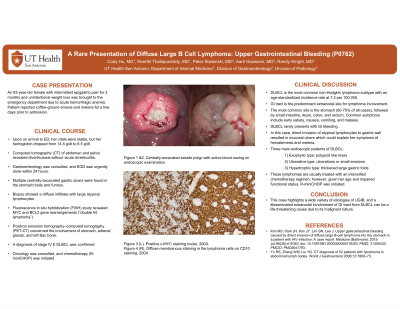Sunday Poster Session
Category: GI Bleeding
P0762 - A Rare Presentation of Diffuse Large B Cell Lymphoma: Upper Gastrointestinal Bleeding
Sunday, October 27, 2024
3:30 PM - 7:00 PM ET
Location: Exhibit Hall E

Has Audio
- CH
Cody Hu, MD
University of Texas Health San Antonio
San Antonio, TX
Presenting Author(s)
Cody Hu, MD1, Keerthi Thallapureddy, MD1, Peter Stawinski, MD2, Aarti Goswami, MD1, Randy Wright, MD1
1University of Texas Health San Antonio, San Antonio, TX; 2University of Texas Health Science Center, San Antonio, TX
Introduction: Diffuse large B cell lymphoma (DLBCL) is the most common non-Hodgkin lymphoma subtype with an age-standardized incidence rate at 7.2 per 100,000. Although gastrointestinal (GI) tract is the predominant extranodal site for lymphoma involvement, DLBCL rarely presents with GI bleeding. Here, we report a case of a stage IV E DLBCL presenting with upper GI bleeding (UGIB) diagnosed at endoscopic examination.
Case Description/Methods: An 83-year-old female with diverticulosis was brought to the emergency department due to acute hemorrhagic anemia. Patient complained coffee-ground emesis and melena a few days prior to admission. Upon on arrival, her vitals were stable, but her hemoglobin dropped from 14.5 g/dl to 8.5 g/dl. Computed tomography of abdomen and pelvis revealed diverticulosis without acute diverticulitis. Gastroenterology was consulted, and esophagogastroduodenoscopy was urgently done. Multiple centrally-excavated gastric ulcers were found in the stomach body and fundus (figure 1a), and the histological biopsy showed a diffuse infiltrate with large atypical lymphocytes (figure 1b & 1c). Subsequent fluorescence in situ hybridization (FISH) study revealed MYC and BCL2 gene rearrangements (“double hit lymphoma”) which predicted an aggressive disease behavior. Positron emission tomography–computed tomography concerned the involvement of stomach, adrenal glands, and left iliac bone. A diagnosis of stage IV E DLBCL was confirmed, and chemotherapy was initiated.
Discussion: UGIB is classified as a bleeding source that originates above the ligament of Treitz with an estimated annual incidence at 80 to 150 per 100,000. It is a common problem that can cause significant morbidity and mortality, and among the etiologies, peptic ulcer disease accounts for 40% to 50% of the cases. Hematologic malignancies are rare causes of UGIB. Along the GI tract, stomach is the most common site of the extranodal lymphoma involvement. In this case, direct invasion of atypical lymphocytes to gastric wall resulted in mucosal ulcers which explained her symptoms of hematemesis and melena. These lymphomas are usually treated with an intensified chemotherapy regimen; however, given her age and impaired functional status, an attenuated chemo-immunotherapy of rituximab, cyclophosphamide, doxorubicin, vincristine and prednisolone was initiated. This case highlights a wide variety of etiologies of UGIB, and a disseminated extranodal involvement of GI tract from DLBCL can be a life-threatening cause due to its malignant nature.

Disclosures:
Cody Hu, MD1, Keerthi Thallapureddy, MD1, Peter Stawinski, MD2, Aarti Goswami, MD1, Randy Wright, MD1. P0762 - A Rare Presentation of Diffuse Large B Cell Lymphoma: Upper Gastrointestinal Bleeding, ACG 2024 Annual Scientific Meeting Abstracts. Philadelphia, PA: American College of Gastroenterology.
1University of Texas Health San Antonio, San Antonio, TX; 2University of Texas Health Science Center, San Antonio, TX
Introduction: Diffuse large B cell lymphoma (DLBCL) is the most common non-Hodgkin lymphoma subtype with an age-standardized incidence rate at 7.2 per 100,000. Although gastrointestinal (GI) tract is the predominant extranodal site for lymphoma involvement, DLBCL rarely presents with GI bleeding. Here, we report a case of a stage IV E DLBCL presenting with upper GI bleeding (UGIB) diagnosed at endoscopic examination.
Case Description/Methods: An 83-year-old female with diverticulosis was brought to the emergency department due to acute hemorrhagic anemia. Patient complained coffee-ground emesis and melena a few days prior to admission. Upon on arrival, her vitals were stable, but her hemoglobin dropped from 14.5 g/dl to 8.5 g/dl. Computed tomography of abdomen and pelvis revealed diverticulosis without acute diverticulitis. Gastroenterology was consulted, and esophagogastroduodenoscopy was urgently done. Multiple centrally-excavated gastric ulcers were found in the stomach body and fundus (figure 1a), and the histological biopsy showed a diffuse infiltrate with large atypical lymphocytes (figure 1b & 1c). Subsequent fluorescence in situ hybridization (FISH) study revealed MYC and BCL2 gene rearrangements (“double hit lymphoma”) which predicted an aggressive disease behavior. Positron emission tomography–computed tomography concerned the involvement of stomach, adrenal glands, and left iliac bone. A diagnosis of stage IV E DLBCL was confirmed, and chemotherapy was initiated.
Discussion: UGIB is classified as a bleeding source that originates above the ligament of Treitz with an estimated annual incidence at 80 to 150 per 100,000. It is a common problem that can cause significant morbidity and mortality, and among the etiologies, peptic ulcer disease accounts for 40% to 50% of the cases. Hematologic malignancies are rare causes of UGIB. Along the GI tract, stomach is the most common site of the extranodal lymphoma involvement. In this case, direct invasion of atypical lymphocytes to gastric wall resulted in mucosal ulcers which explained her symptoms of hematemesis and melena. These lymphomas are usually treated with an intensified chemotherapy regimen; however, given her age and impaired functional status, an attenuated chemo-immunotherapy of rituximab, cyclophosphamide, doxorubicin, vincristine and prednisolone was initiated. This case highlights a wide variety of etiologies of UGIB, and a disseminated extranodal involvement of GI tract from DLBCL can be a life-threatening cause due to its malignant nature.

Figure: Figure 1. (a) centrally-excavated sessile polyp on endoscopic examination. (b) diffuse membranous staining in the lymphoma cells on CD10 staining, 200X. (c) positive c-MYC staining nuclei, 200X.
Disclosures:
Cody Hu indicated no relevant financial relationships.
Keerthi Thallapureddy indicated no relevant financial relationships.
Peter Stawinski indicated no relevant financial relationships.
Aarti Goswami indicated no relevant financial relationships.
Randy Wright indicated no relevant financial relationships.
Cody Hu, MD1, Keerthi Thallapureddy, MD1, Peter Stawinski, MD2, Aarti Goswami, MD1, Randy Wright, MD1. P0762 - A Rare Presentation of Diffuse Large B Cell Lymphoma: Upper Gastrointestinal Bleeding, ACG 2024 Annual Scientific Meeting Abstracts. Philadelphia, PA: American College of Gastroenterology.
